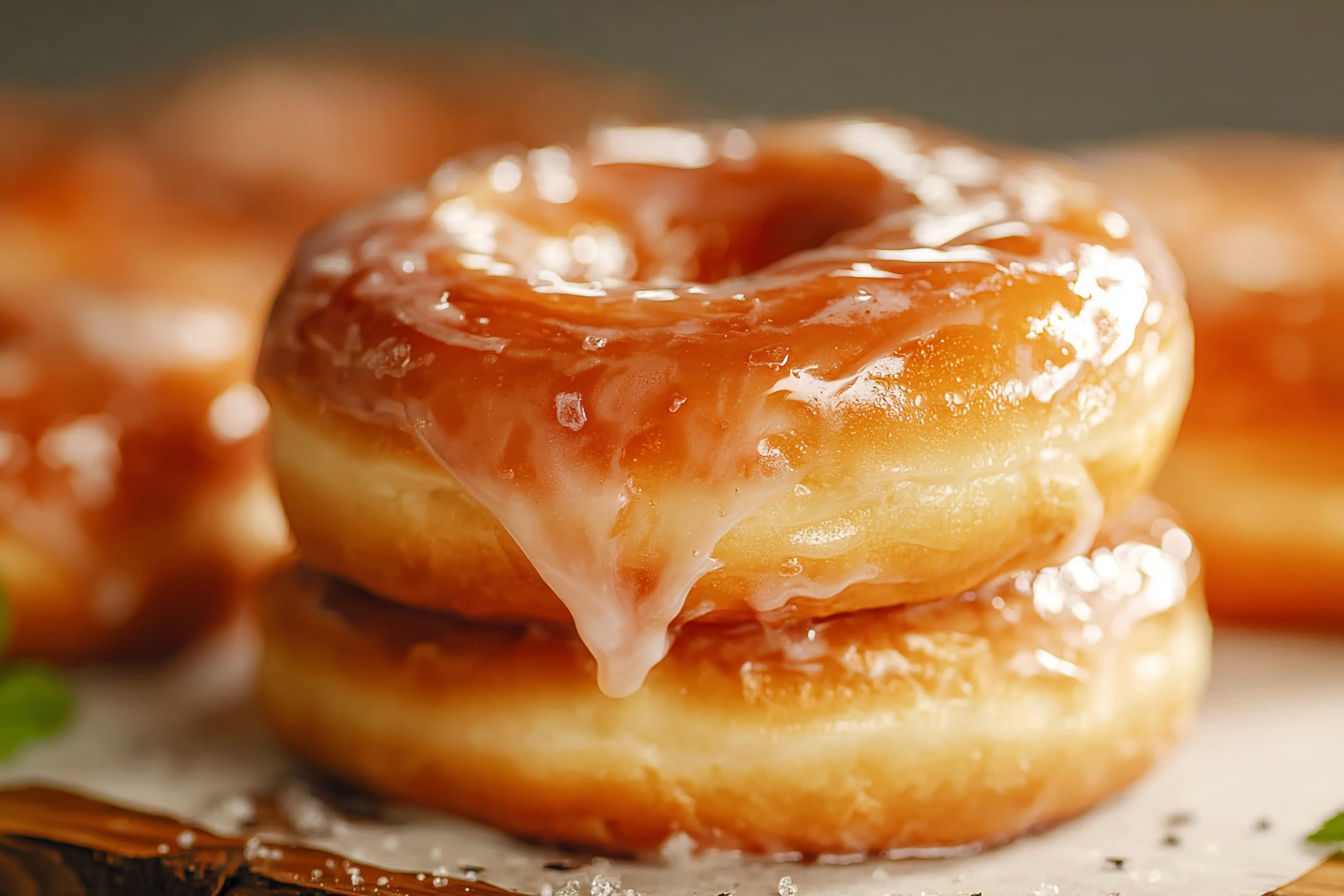Glazed donuts are more than just a sweet treat—they’re a nostalgic experience, a morning ritual, and for many, the first bite of comfort food bliss. Here at Cooking Flash, our About page says it best: we started our journey to share timeless family recipes that bring warmth, joy, and flavor into everyday kitchens. And glazed donuts? They’ve been with us since the beginning, one of the first indulgent desserts our founder made with her grandmother on a Sunday morning.
In this article, we’re diving deep into everything glazed donuts. From their rich history and homemade recipe secrets to trendy twists like glazed donuts nails and the ongoing battle between Krispy Kreme and Dunkin’, we’ll leave no glaze unturned. You’ll also get a complete, step-by-step recipe tested in our kitchen, with practical cooking tips to help you get that perfect soft center and glossy finish. Whether you’re a newbie baker or a seasoned donut-lover, this guide delivers everything you need to master the art of the perfect glazed donut.
Don’t miss our Frozen Mud Pie – a frozen treat lover’s dream for dessert ideas after you nail this recipe.
Table of Contents
Table of Contents
The Sweet History and Meaning Behind Glazed Donuts
Where Did Glazed Donuts Originate?
The exact origin of glazed donuts is a mix of culinary folklore and fact. Most historians trace donuts back to early Dutch settlers in North America, who made fried dough cakes known as “olykoeks.” But it wasn’t until the 19th century that the classic ring shape appeared. Legend says a sailor named Hanson Gregory punched a hole in his dough ball to help it cook evenly—thus, the modern donut was born.
As for the glaze? That came later, inspired by sugary European pastries. It started appearing in American kitchens during the mid-1800s and quickly became the preferred coating for doughnuts. Soft, warm, and sweet—it was the perfect combo. By the 20th century, brands like Krispy Kreme made glazed donuts a household favorite.
Today, whether you’re grabbing a box at the grocery store or frying them fresh at home, glazed donuts have become synonymous with American breakfasts and weekend indulgences.
What Does “Glazed Donuts” Really Mean? (Cultural + Slang Use)
In the culinary world, “glazed donuts” refer to donuts covered in a thin, shiny coating made from powdered sugar and milk or cream. That shine is key—it gives the donut its irresistible, sticky finish.
But in pop culture and slang, “glazed donut” has taken on humorous or cheeky meanings. From describing someone who’s overly sweet (or acting spaced out) to internet memes and double entendres, the term has found its way into everyday language.
Still, for most, it’s all about that soft, fluffy inside and melt-in-your-mouth glaze on top. And when people search for glazed donuts near me, they’re thinking of warm, sweet happiness—not slang!
Understanding What Glazed Donuts Are Made Of
What Is Glaze on Donuts Made Of?
The glaze is the finishing touch that transforms a basic fried dough ring into a glazed donut masterpiece. But what exactly goes into that shiny, sweet coating?
Traditionally, donut glaze is made from confectioners’ sugar, a splash of milk or heavy cream, and vanilla extract for flavor. It’s whisked until smooth and silky. When a warm donut gets dipped into this mixture, the glaze clings, drips slightly, then sets into a glossy, melt-in-your-mouth coating. This process is what gives glazed donuts their iconic look and flavor.
The magic lies in its simplicity. Yet, that basic trio—powdered sugar, dairy, and vanilla—delivers a glaze that balances sweetness with texture. Some bakers get creative, adding citrus zest, maple syrup, or cinnamon, but the classic version is hard to beat.
The key to the perfect glaze? Temperature. Donuts must be warm, but not hot, and the glaze must be at room temp—not too thick, not too thin. If the glaze runs off or clumps up, something’s off.
Want to see this in action? Check out our Baby Trail Mix for a fun brunch pairing idea after you glaze up your donuts.
Core Ingredients for Classic Glazed Donuts
So, what exactly goes into classic glazed donuts? Beyond the glaze, the dough itself needs the perfect balance of richness, rise, and flavor. Here’s a breakdown of the key ingredients used in our homemade recipe:
| Ingredient | Purpose |
|---|---|
| Whole Milk (warm) | Activates the yeast and softens the dough |
| Instant Yeast | Helps the donuts rise and get fluffy |
| Granulated Sugar | Adds sweetness and feeds the yeast |
| Eggs | Enrich the dough and provide structure |
| Butter (melted) | Makes the dough tender and flavorful |
| Vanilla Extract | Adds aroma and taste depth |
| Ground Nutmeg | Classic bakery note often missed at home |
| Salt | Balances flavor and strengthens gluten |
| All-purpose Flour | Forms the base of the dough |
| Vegetable Oil | Used for frying the donuts to golden perfection |
What makes this combination magical is the balance between fat, flour, and yeast. You want a slightly sticky dough, but not wet. Too dry and the donuts will turn dense; too soft and they’ll collapse after frying.
And let’s talk glaze again—made of:
- 2 cups powdered sugar
- 1/3 cup cream or milk
- 1/2 tsp vanilla extract
Each element works together to give the final product its signature light texture and rich taste. If you’re trying to recreate Krispy Kreme glazed donuts, the trick is getting the dough light and airy and letting it rise fully before frying.
Discover great ideas like our Amaretto Cherry Jam if you want something to smear on those leftover donut holes!
Print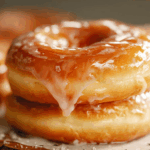
Irresistibly Delicious Glazed Donuts You Need to Make Today
- Prep Time: 2 hours 30 minutes
- Cook Time: 20 minutes
- Total Time: 2 hours 50 minutes
- Yield: 12–14 doughnuts + holes
- Category: Breakfast, Dessert
- Method: Frying
- Cuisine: American
- Diet: Vegetarian
Description
These classic homemade glazed doughnuts are light, fluffy, and fried to golden perfection, then dipped in a sweet vanilla glaze. A delicious treat for any time of day.
Ingredients
- 1 cup (240ml) whole milk, warmed to about 110°F (43°C)
- 2 and 1/4 teaspoons (7g) instant or active dry yeast (1 standard packet)
- 1/3 cup (65g) granulated sugar, divided
- 2 large eggs
- 6 Tablespoons (85g) unsalted butter, melted and slightly cooled
- 1 teaspoon pure vanilla extract
- 1/4 teaspoon ground nutmeg
- 1/2 teaspoon salt
- 4 cups (500g) all-purpose flour, plus more as needed
- 1–2 quarts vegetable oil (for frying)
- Donut Glaze:
- 2 cups (240g) confectioners’ sugar, sifted
- 1/3 cup (80ml) heavy cream, half-and-half, or whole milk
- 1/2 teaspoon pure vanilla extract
Instructions
- Whisk warm milk, yeast, and 1 tablespoon sugar in a bowl. Cover and let sit for 5–10 minutes until foamy.
- Add remaining sugar, eggs, melted butter, vanilla, nutmeg, salt, and 2 cups of flour. Beat on low speed for 1 minute. Scrape sides as needed.
- Add the remaining flour and beat on medium speed until dough forms and pulls away from the bowl. Add more flour a tablespoon at a time if too sticky.
- Knead for 5–7 minutes (in mixer or by hand) until soft and slightly tacky. Dough should bounce back when poked.
- Place dough in a greased bowl, cover, and let rise for 1.5–2 hours until doubled in size.
- Punch dough down and roll out to 1/2 inch thickness. Cut into doughnuts using a doughnut cutter or round cutters.
- Place on lined baking sheets, cover loosely, and let rest for 30 minutes. Meanwhile, heat oil to 375°F (191°C) in a large pot.
- Fry 2–3 doughnuts at a time, 1 minute per side. Remove with slotted spoon and place on cooling rack. Repeat with remaining doughnuts.
- To make glaze, whisk confectioners’ sugar, cream or milk, and vanilla together.
- Dip each warm doughnut into the glaze, coating both sides. Place back on rack and let set for 20 minutes.
- Enjoy fresh. Store leftovers in an airtight container at room temperature or in the fridge for 1–2 days.
Notes
- Use an oil thermometer to maintain consistent frying temperature.
- Doughnut holes can be fried for 30 seconds per side.
- Best served fresh the same day.
- If dough is too sticky, add flour sparingly to avoid drying it out.
- Allow glaze to set for cleaner presentation.
Nutrition
- Serving Size: 1 doughnut
- Calories: 300
- Sugar: 18g
- Sodium: 150mg
- Fat: 15g
- Saturated Fat: 5g
- Unsaturated Fat: 8g
- Trans Fat: 0g
- Carbohydrates: 38g
- Fiber: 1g
- Protein: 4g
- Cholesterol: 45mg
How to Make Perfect Homemade Glazed Donuts
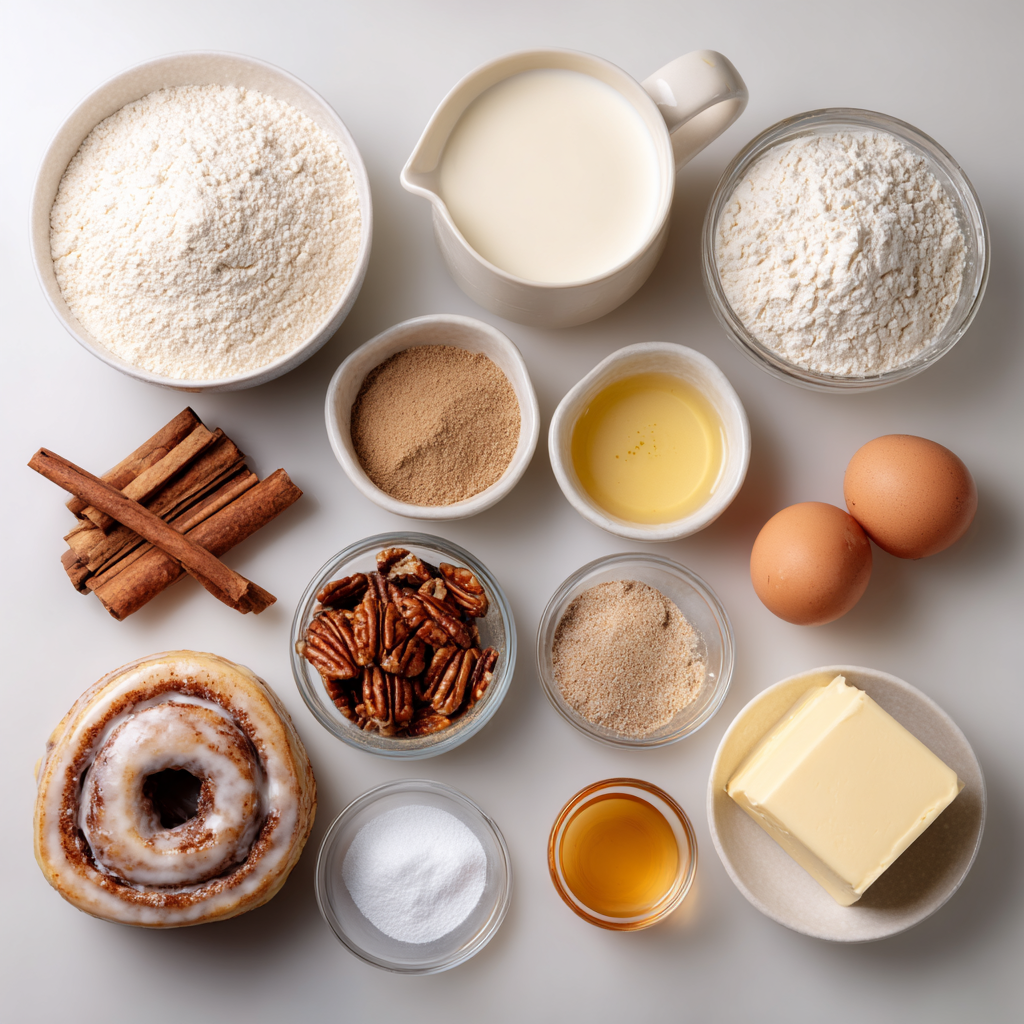
Ingredients Breakdown: From Yeast to Vanilla
Crafting homemade glazed donuts is easier than you think—when you understand what each ingredient does in the recipe. Unlike boxed mixes or frozen donuts, this dough is alive with texture, aroma, and flavor. Let’s revisit and break down the most important ingredients in the process:
- Whole Milk (warm): The warmth (around 110°F) is key. Not too hot to kill the yeast, not too cold to stall it. It activates the yeast and provides richness.
- Yeast (instant or active dry): This creates the rise. A full packet ensures your donuts puff up beautifully when they fry.
- Granulated Sugar: Sugar isn’t just sweet—it feeds the yeast and softens the dough.
- Eggs: Eggs bind everything and give the donuts that fluffy crumb inside.
- Melted Butter: Adds moisture and a silky texture. Your donuts will never taste dry with the right amount of fat.
- Vanilla Extract: Just a teaspoon, but it changes everything. Gives the dough and glaze that heavenly bakery aroma.
- Nutmeg: A subtle flavor found in almost all bakery donuts—it gives off that “classic donut shop” vibe.
- Salt: Without it, your donuts would taste flat. Salt highlights all the other flavors.
- Flour: All-purpose works great. Use it gradually to avoid a dense, tough dough.
- Vegetable Oil: Frying medium of choice. High smoke point, clean flavor, and golden crust guaranteed.
These ingredients work together to form a rich, airy dough that’s easy to shape and even easier to love once you dip it in glaze.
Step-by-Step Dough Preparation Explained
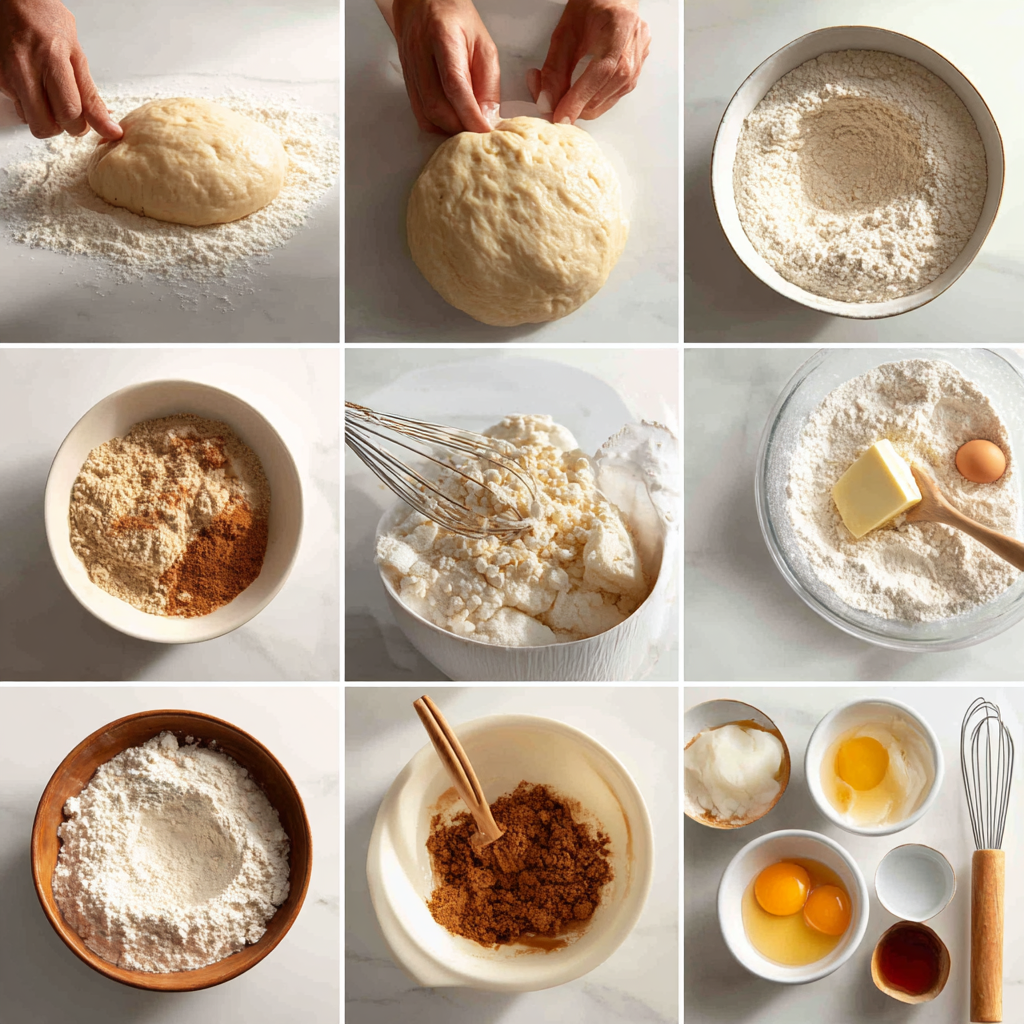
Let’s roll up our sleeves and start making magic. Follow these detailed instructions and you’ll be biting into warm, homemade glazed donuts in no time.
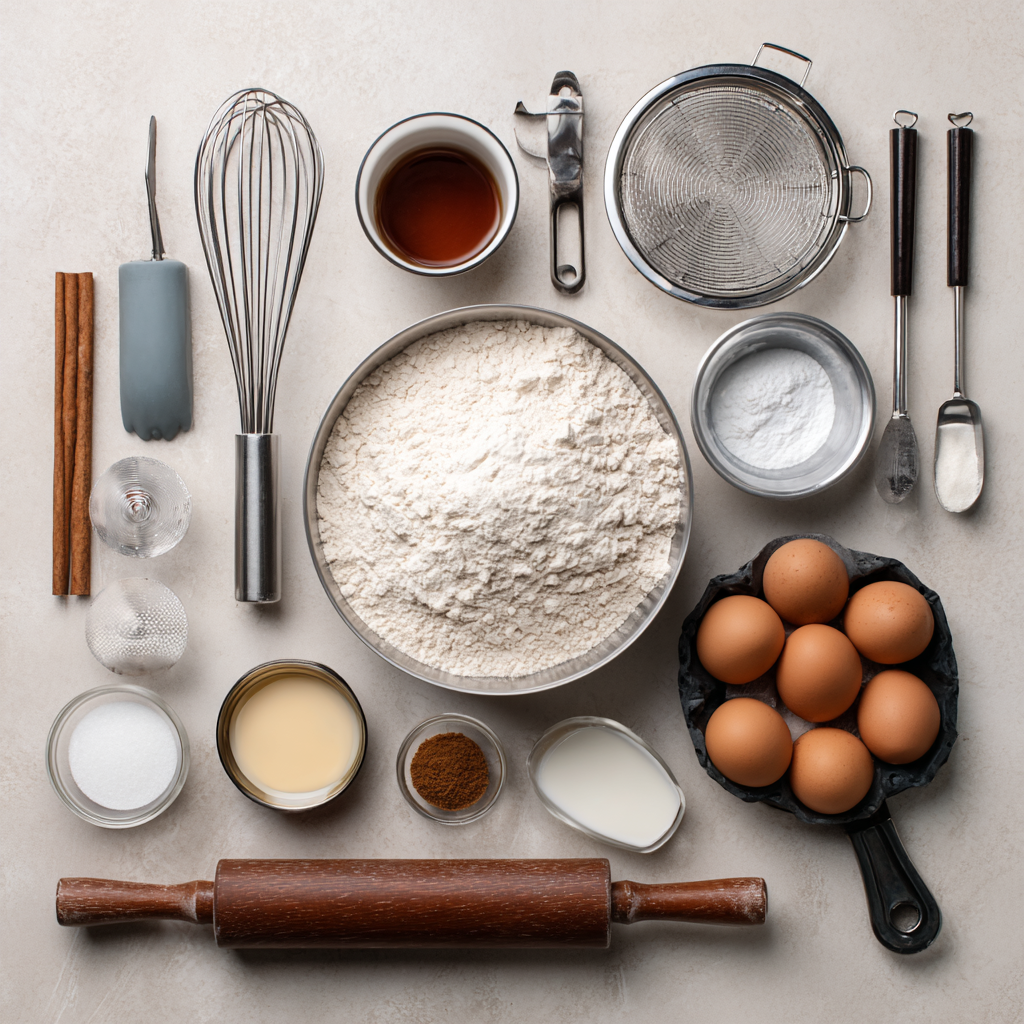
1. Activate the Yeast
In your stand mixer bowl (or a large mixing bowl if doing it by hand), whisk together warm milk, 1 tablespoon sugar, and the yeast. Cover loosely and let sit for about 5–10 minutes. You’ll know it’s ready when you see bubbles and foam—signs the yeast is alive and kicking.
2. Add Wet Ingredients + Initial Flour
Add in the rest of the sugar, eggs, melted butter, vanilla extract, nutmeg, and salt. Add 2 cups of flour and mix on low speed for 1 minute until roughly combined. Scrape down the sides to make sure everything blends evenly.
3. Add Remaining Flour and Knead
Gradually add the rest of the flour. Increase mixer speed to medium and beat until the dough pulls away from the bowl. If it’s still sticking too much, add more flour 1 tablespoon at a time. You’re aiming for a soft, slightly sticky consistency.
Now, knead! In a mixer with a dough hook, go for 5–7 minutes. Or knead by hand on a floured surface for the same time. It should pass the windowpane test—stretch a small ball of dough until it’s thin enough for light to pass through without tearing.
4. First Rise: Let the Dough Double
Grease a large bowl, place the dough inside, and turn it to coat all sides. Cover and let rise for 1.5 to 2 hours in a warm, draft-free spot. It should double in size.
5. Shape the Donuts
Punch down the dough and roll it out on a lightly floured surface to 1/2-inch thick. Use a donut cutter (or two different-sized biscuit/cookie cutters) to shape your rings. Re-roll scraps as needed.
6. Rest Again While Heating Oil
Place the shaped donuts on parchment-lined trays and cover loosely. Let them rest for 30 minutes while you heat your oil to 375°F (191°C).
7. Fry the Donuts
Add 2–3 donuts at a time. Cook 1 minute per side until golden brown. Carefully remove with a slotted spoon and place on a wire rack over a baking tray.
Pro Tip: If your oil runs hot, lower the heat slightly. Consistent 375°F is your secret to that perfect crispy outside and fluffy inside.
Once they’re out, you’re just a glaze away from sweet victory.
Frying vs Baking: Methods to Cook Glazed Donuts
How to Fry Glazed Donuts Safely
Frying is the traditional—and let’s face it, the most delicious—way to prepare glazed donuts. That crispy outer shell paired with a pillowy soft interior is what donut dreams are made of.
To get started, you’ll need:
- A heavy-bottomed pot or Dutch oven (helps retain steady heat)
- A deep-fry thermometer
- Vegetable oil (2–3 quarts depending on pot size)
- Metal slotted spoon or spider skimmer
- A cooling rack set over a lined tray for draining
Here’s how to do it:
- Heat oil to 375°F (191°C). Anything less and the donuts absorb oil and turn greasy. Too hot and the outside burns before the inside cooks.
- Fry 2–3 donuts at a time to avoid dropping the oil temperature. Gently lower them into the oil and let cook for 1 minute per side, flipping once.
- Remove carefully and place directly on a wire rack. If you drain on paper towels, the bottoms can get soggy.
- While they’re warm, dip them into your glaze mixture and place them back on the rack to set.
Worried about oil splatter? Use long tongs or wear kitchen gloves, and don’t overcrowd the pot. The oil will stay clean longer, and the donuts will cook more evenly.
Frying brings out the best in glazed donuts—light, tender interiors and a thin, crackly glaze coating.
For a fun snack on the side, Explore our Strawberry Crunch Cheesecake Chunks—a great no-fry dessert to contrast these golden treats.
Is Baking a Healthier Option for Glazed Donuts?
It’s a fair question—can baked glazed donuts match up?
Baking offers a lower-calorie alternative and cuts out the mess of deep frying. However, the texture and taste differ. Baked donuts have a denser, more cake-like crumb and lack that crispy edge you get from hot oil.
Still, for those who want to indulge more mindfully, baked glazed donuts are a solid option. You’ll need a nonstick donut pan and a few tweaks to the recipe. Here’s what changes:
| Step | Fried Donuts | Baked Donuts |
|---|---|---|
| Texture | Light and airy inside, crisp outside | More cake-like, moist |
| Calories | Higher due to oil absorption | Lower fat content |
| Time | Longer, due to proofing and frying | Faster, no frying mess |
| Tools Needed | Fryer/pot, thermometer | Donut pan, oven |
For baked versions:
- Preheat oven to 350°F (177°C)
- Lightly grease donut pans
- Pipe or spoon dough into molds, filling 2/3 full
- Bake for 10–12 minutes until lightly golden
- Dip in glaze while warm
Whether baked or fried, glazed donuts can deliver that sweet satisfaction. The best method? That depends on your mood (and your patience).
Secrets to a Glossy, Perfect Glaze Coating
Mastering the Art of Donut Glaze: Tips for Even, Glossy Coverage
When it comes to making truly irresistible glazed donuts, it’s not just about the dough—it’s about getting that glaze just right. The perfect glaze should be smooth, slightly translucent, and stick like a dream without sliding off or hardening into candy. It sounds simple, but a lot of donut lovers miss the mark.
Let’s break down exactly how to achieve that flawless, shiny finish every time:
- Always start by sifting your powdered sugar. Even the finest sugar clumps. Sifting guarantees a silky glaze texture with no unpleasant sugar lumps.
- Use a low, wide bowl for glazing. This lets you dip each donut fully and evenly, coating both sides with minimal mess.
- Dip your donuts while they’re still warm—not hot, not cold. Warm donuts absorb glaze better, ensuring it clings rather than slides off.
- Double-dip for extra coverage if you want that thicker, bakery-style coating. Just wait a few seconds between dips to allow the first layer to set slightly.
- Let your donuts rest on a wire rack placed over a lined sheet. This not only catches drips but ensures air circulates around the donut, helping the glaze set with a glossy finish.
These easy techniques turn your homemade donuts into showstoppers. You’ll get that sticky-finger shine that reminds you of walking into a donut shop at 8 a.m. on a Sunday.
Want something sweet to serve alongside? Try our Strawberry Crunch Cheesecake Chunks—they’re a rich, no-glaze-needed dessert that balances out the sugar rush.
Choosing the Right Liquid for Glaze: Creamy, Light, or Classic?
Believe it or not, the type of liquid you use in your donut glaze has a huge effect on flavor, shine, and texture. While most go straight for milk, you have options—and each one creates a different kind of magic.
Here’s a side-by-side comparison:
| Liquid Type | Glaze Texture | Flavor Impact | Visual Finish |
|---|---|---|---|
| Whole Milk | Balanced and pourable | Slight creaminess | Shiny, soft set |
| Heavy Cream | Thicker and richer | Deep, decadent flavor | Glossy, luxurious |
| Water | Very thin | Light, subtle | Slightly matte |
| Half-and-Half | Creamy and smooth | Mild, sweet finish | Silky, balanced shine |
So, what’s the best liquid? For traditional glazed donuts, whole milk or heavy cream gives the most satisfying mouthfeel and professional sheen. The added fat in cream helps the glaze cling better, while milk strikes a perfect balance for home bakers.
Try this classic glaze formula:
- 2 cups powdered sugar (sifted)
- 1/3 cup milk or cream
- ½ teaspoon pure vanilla extract
Whisk until it’s completely smooth. Adjust thickness by adding small amounts of sugar or liquid. Want more flavor? Mix in almond extract or a touch of citrus zest for a gourmet twist.
Pro Tip: Avoid glazing hot donuts—glaze will melt off and leave a sticky mess. Aim for donuts that are warm to the touch, not steaming.
The Ultimate Glazed Donuts Recipe (With Tips)
Your Complete Guide to Making Fluffy, Glazed Donuts from Scratch
Craving that golden, pillowy bite of a fresh glazed donut, warm from the fryer with a melt-in-your-mouth sugar coating? Skip the drive-thru. You’re about to learn how to make bakery-style glazed donuts at home—light, fluffy, and dripping with vanilla glaze that sets just right.
This recipe is designed to walk you through every stage, from mixing and rising to frying and glazing. With some simple ingredients and a little know-how, you’ll be creating donuts that rival anything from Krispy Kreme or Dunkin’.
Essential Ingredients for Perfect Homemade Glazed Donuts
For the Dough
- 1 cup warm whole milk (around 110°F)
- 2¼ teaspoons active dry yeast (or instant)
- ⅓ cup white sugar (1 tbsp reserved for yeast activation)
- 2 large eggs
- 6 tablespoons unsalted butter, melted and cooled
- 1 teaspoon vanilla extract
- ¼ teaspoon ground nutmeg
- ½ teaspoon fine salt
- 4 cups all-purpose flour (leveled, plus extra for dusting)
- 1–2 quarts vegetable oil for deep frying
For the Glaze
- 2 cups sifted powdered sugar
- ⅓ cup heavy cream, whole milk, or half-and-half
- ½ teaspoon vanilla extract
How to Make Glazed Donuts – Step by Step
Step 1: Activate the Yeast
Combine the warm milk, yeast, and 1 tablespoon of sugar in a large bowl. Stir and let it sit uncovered for 5–10 minutes until a foamy layer forms. This ensures your yeast is alive and active.
Step 2: Add the Remaining Ingredients
Once the yeast is bubbly, add the rest of the sugar, eggs, butter, vanilla, nutmeg, and salt. Stir to combine, then add 2 cups of flour and mix until a sticky dough begins to form.
Step 3: Build the Dough
Add the rest of the flour gradually, continuing to mix until the dough pulls cleanly from the sides of the bowl. It should be soft, elastic, and slightly tacky—not dry or crumbly.
Step 4: Knead Until Smooth
Knead by hand or use a stand mixer with a dough hook for 6–8 minutes. You’ll know it’s ready when you can stretch the dough thin without tearing—a sign the gluten has developed fully.
Letting the Dough Rise and Shaping Your Donuts
Step 5: First Rise
Transfer the dough to a lightly greased bowl, cover it with a clean towel or plastic wrap, and let it rest in a warm spot for 90 minutes or until doubled in size.
Step 6: Roll and Cut
Punch down the risen dough and roll it out on a floured surface to about ½-inch thick. Cut donuts using a donut cutter or two round cutters (one large, one small). Repeat until all dough is shaped.
Step 7: Let Them Rest Again
Place the donuts and holes on parchment-lined trays. Cover loosely and let them proof for another 30 minutes as they puff slightly and hold shape better during frying.
Time to Fry and Glaze
Step 8: Heat the Oil
In a heavy-bottomed pot, heat oil to 375°F. Fry 2–3 donuts at a time, about 1 minute per side, until deep golden brown. Flip carefully and don’t overcrowd the pot—this helps maintain even cooking and temperature.
Drain donuts on a wire rack set over a baking sheet.
Step 9: Glaze While Warm
Mix the powdered sugar, cream (or milk), and vanilla until smooth. Dip each warm donut directly into the glaze—either one side or both for full coverage. Allow excess glaze to drip off, then place donuts back on the rack to set.
Helpful Tips for Better Donuts
- Don’t rush the rise: The longer proofing helps build soft, airy texture.
- Test your oil: If it’s too hot, donuts will brown before the inside cooks.
- Glaze at the right temp: Donuts should be warm but not hot, or the glaze may melt off.
- Customize: Add a dash of cinnamon, maple extract, or citrus zest to the glaze for seasonal flair.
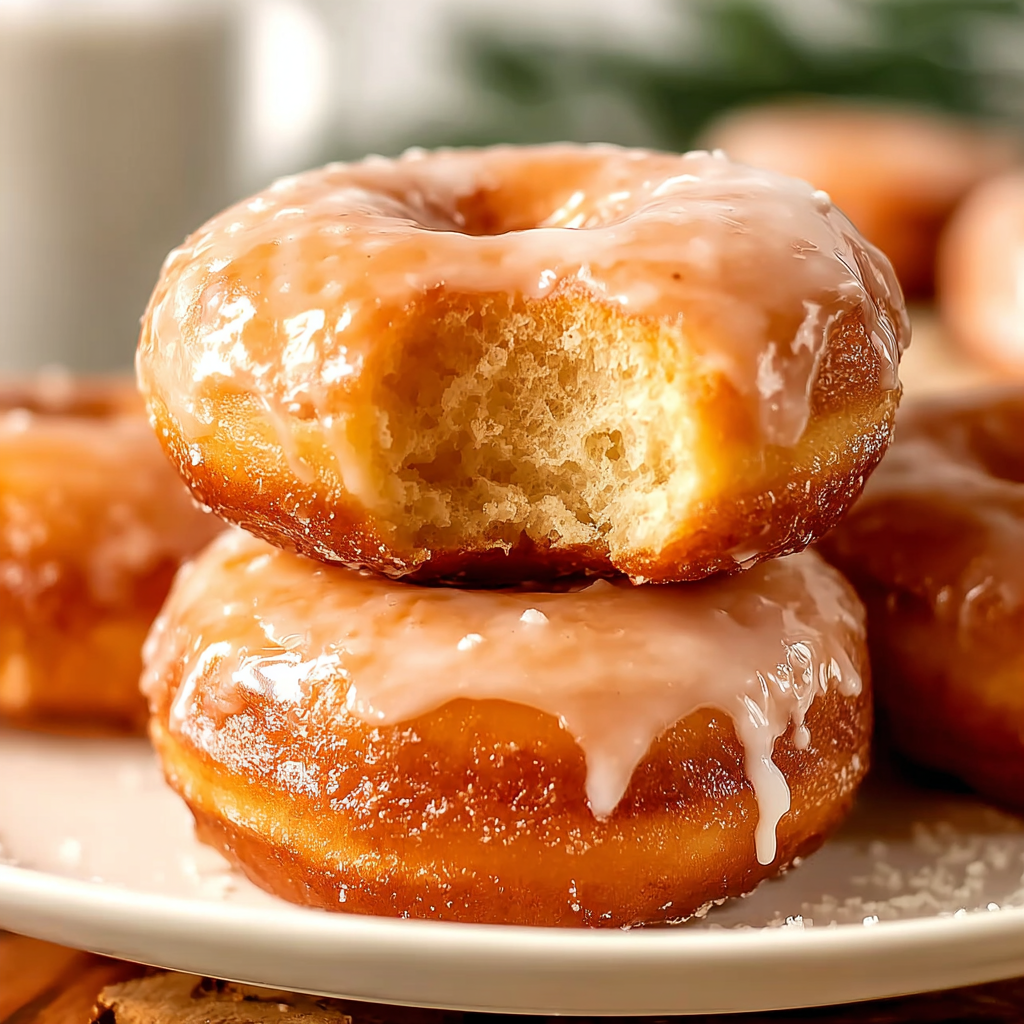
Glazed Donuts Styles Compared – From Krispy Kreme to Dunkin’
What Makes Krispy Kreme Glazed Donuts So Iconic?
There’s something about a fresh, warm Krispy Kreme glazed donut that makes people pull over mid-commute. But what’s the real secret?
Krispy Kreme’s dough is incredibly light, almost airy. Their donuts are proofed longer, which results in a softer, puffier interior. But it’s the glaze application—dipped while warm and allowed to set under a glaze waterfall—that gives it that signature sheen and melt-away texture.
Their original recipe is also high in sugar and uses a custom fat blend for frying, giving their donuts a golden, barely-there crust. It’s no wonder that searches for glazed donuts Krispy Kreme surge every morning.
Want to pair something creamy with these melt-in-your-mouth bites? Looking for inspiration? Try this Orange Creamsicle Poke Cake.
How Dunkin’ Glazed Donuts Stand Out
While Krispy Kreme leans light and fluffy, Dunkin’ glazed donuts offer a slightly denser bite. They’re made for dipping in coffee, so they hold up without falling apart.
What sets them apart:
- A cake-like texture with more structure
- A thinner glaze that’s not overpowering
- More variety in sizes and shapes
For those who want a more filling glazed donut, Dunkin’ delivers on substance. While some may prefer Krispy Kreme’s melt-in-your-mouth approach, others appreciate Dunkin’s hearty, nostalgic flavor.
Searching for glazed donuts dunkin donuts often leads to donut loyalty debates—both styles have their die-hard fans.
Trendy Twists: Glazed Donuts Nails and Beyond
Not all glazed donuts are edible. That’s right—the internet’s obsession with glazed donut nails has exploded in recent years. Made popular by celebrities and beauty influencers, this trend mimics the sheer, shiny finish of a classic glazed donut on fingernails.
It’s all about:
- Neutral tones (think pale pinks and nudes)
- A glossy, pearlescent top coat
- A smooth, reflective surface—just like that fresh glaze
It’s the perfect crossover between food and fashion. Just search glazed donuts nails on social media and you’ll find millions of polished results.
If you love multitasking trends, Check out our Amaretto Cherry Jam for another sweet idea that looks as good as it tastes.
Homemade vs Store-Bought: Which One Wins?
Let’s settle this once and for all. Can a homemade glazed donut compete with the classics?
| Feature | Homemade Donuts | Krispy Kreme/Dunkin’ |
|---|---|---|
| Texture | Customizable: fluffy or cakey | Pre-set textures |
| Glaze | You control the thickness and flavor | Standard vanilla glaze |
| Ingredients | Fresh, no preservatives | Processed for shelf life |
| Cost | Low (especially in batches) | Higher for less quantity |
| Experience | Personal, fun, creative | Convenient but less hands-on |
In short, homemade wins for freshness and flavor, while the big names offer consistency and speed. Plus, your home version lets you tweak the recipe for gluten-free, vegan, or filled variations. Searching for easy doughnut recipe or glazed donuts near me is often what brings people to try DIY instead of drive-thru.
Next-Level Ideas and Custom Glazes
Now that you’ve nailed the traditional recipe, why not experiment with twists?
Here are a few upgrades to try:
- Maple or chocolate glaze
- Fillings: jam, custard, or Nutella
- Toppings: crushed nuts, cinnamon sugar, or even cereal
- Vegan substitutes: almond milk, flaxseed eggs, and coconut oil
- Gluten-free flour blends for dietary needs
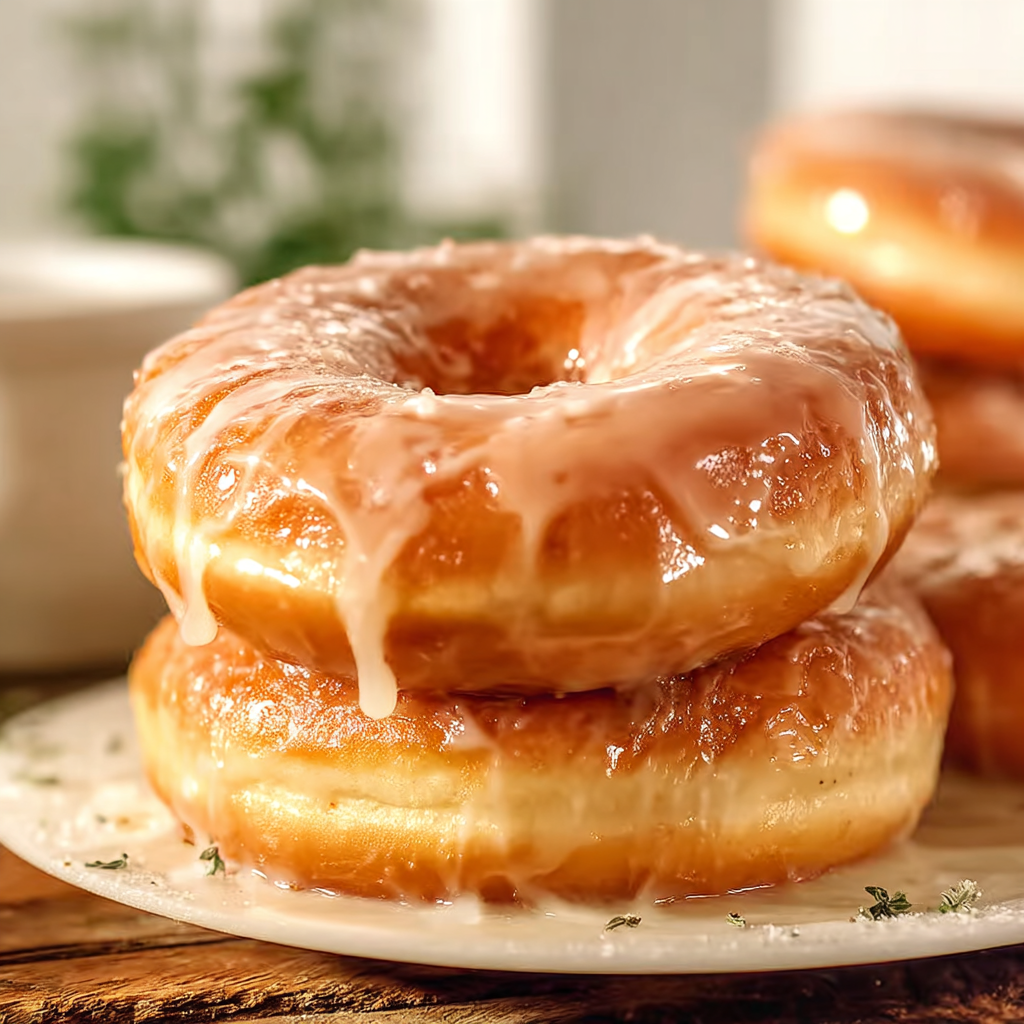
Nutrition, Health, and Are Glazed Donuts Really That Bad?
Are Glazed Donuts Actually Unhealthy? Let’s Break It Down
It’s the question we all whisper while enjoying that sweet, soft bite—are glazed donuts healthy? The short answer: not really. But let’s not judge too fast. Like most indulgent treats, glazed donuts aren’t meant to be the enemy; they’re meant to be an occasional joy.
So, what makes a donut less than ideal for daily snacking? It comes down to:
- Refined sugars
- White flour
- Deep frying in oil
Each donut, depending on size and glaze thickness, can pack between 190 to 300 calories, and contain around 10–18 grams of sugar. They’re also relatively low in protein and fiber, which means they won’t keep you full for long.
But here’s the thing: a donut isn’t pretending to be a salad. It’s dessert. And when eaten mindfully—paired with a protein-rich breakfast or enjoyed on its own as a weekend treat—it doesn’t have to ruin your lifestyle.
What’s Actually in That Glaze? Ingredients You Should Know
If you’re wondering what is glaze on donuts made of, you’re not alone. The glaze may look fancy, but it’s incredibly simple—and often customizable.
Basic donut glaze includes:
- Powdered sugar
- Milk or cream
- Vanilla extract
That’s it. No preservatives, no artificial colors—unless added at commercial level. When you make glazed donuts at home, you control the ingredients. You can even use alternative sweeteners like monk fruit or maple syrup, and plant-based milks for a healthier take.
Pro Tip: Add cinnamon or matcha powder to your glaze for antioxidant benefits and flavor depth.
Want a healthy homemade pairing? Discover our Baby Trail Mix—a great balance of crunch, protein, and sweetness to go with your donuts.
Can You Make Glazed Donuts Healthier?
Absolutely. Here are smart ways to upgrade your recipe without losing the joy:
- Bake Instead of Fry: Baked donuts reduce fat content by nearly half.
- Use Whole Wheat or Oat Flour: Increases fiber and adds texture.
- Opt for Coconut or Avocado Oil: These oils have healthier fat profiles than traditional vegetable oils.
- Go Vegan: Substitute eggs with flaxseed, and use almond or soy milk.
- Reduce the Glaze: Dip only one side or drizzle instead of dunking.
The result? A donut that satisfies cravings but doesn’t sabotage your goals.
Need inspiration for a better-for-you sweet treat? Check out our Strawberry Crunch Cheesecake Chunks for another better-for-you option that still hits the spot.
Mindful Eating: Enjoy Donuts Without Guilt
Rather than seeing donuts as a cheat or a “bad” food, consider them part of a balanced mindset. Eating well isn’t about cutting out joy—it’s about choosing when and how to indulge.
Tips for balanced enjoyment:
- Pair with protein (like yogurt or eggs) to slow sugar absorption.
- Eat slowly and savor every bite.
- Don’t eat distracted—enjoy your glazed donut with intention.
- Skip sugary drinks alongside them to reduce the sugar overload.
There’s nothing wrong with giving yourself permission to enjoy your favorite food now and then. Especially when it’s a homemade glazed donut, fresh from the kitchen and dipped in love.
Glazed Donuts Are the Sweet Simplicity We All Crave
Glazed donuts hold a special place in the world of comfort food. That delicate outer glaze, the golden shell, and the soft, pillowy center offer a kind of satisfaction that few desserts can match. Whether you’re reaching for one fresh from your kitchen or reminiscing about your favorite donut shop run, there’s no denying the charm these classics carry.
Making glazed donuts at home gives you control over every layer of flavor—from the subtle hint of vanilla in the dough to the smooth, sugary finish on top. It’s a process that connects tradition with creativity, giving you freedom to stick with the tried-and-true or branch out with fillings, flavored glazes, or even baked alternatives.
So whether you’re planning a weekend treat, a sweet surprise for loved ones, or simply answering a sugar craving the old-fashioned way, glazed donuts always deliver. They’re easy to personalize, fun to share, and unforgettable when done right.
Looking to build your next sweet moment? Check out our Frozen Mud Pie or explore more from our dessert collection for irresistible ideas beyond the basics.
Go ahead—roll, fry, dip, and enjoy every bite. Because when life gets hectic, sometimes all you need is a warm, homemade glazed donut to slow things down and sweeten it up.Tray this recipe :Cinnamon Rolls Donut
What does glazed donut mean in slang?
In slang, the phrase “glazed donut” can have playful, often humorous meanings depending on the context. It’s sometimes used to describe someone who looks spaced out or shiny-faced, as if they’ve been sweating or just woken up. The term can also be used affectionately to poke fun at someone who’s a little out of it.
In other contexts, it might take on more adult or tongue-in-cheek meanings, but in everyday language, it’s usually harmless and light-hearted.
Are glaze donuts healthy?
Glazed donuts are delicious—but they’re not considered a health food. They’re typically high in refined carbs, sugar, and fat, and don’t offer much in terms of vitamins or fiber. A single donut can run around 250–300 calories with up to 18 grams of sugar.
That said, enjoying a donut occasionally as part of a balanced diet is absolutely okay. You can even make healthier versions at home by baking instead of frying, using whole grain flour, or reducing the glaze.
What is meant by glazed donuts?
A glazed donut refers to a fried or baked doughnut that’s coated in a sweet sugar glaze. It’s the glaze that gives the donut its shiny appearance and sweet outer layer. The inside is typically soft, light, and airy—perfectly complementing the thin layer of sugary icing on top.
When people think of a “traditional” donut, a glazed one usually comes to mind first.
What is glaze on donuts made of?
The classic glaze you find on most glazed donuts is made from just three basic ingredients: powdered sugar, milk (or cream), and vanilla extract. The mixture is whisked until smooth and slightly runny, creating a thin coating that hardens into a glossy finish once it sets.
Homemade versions let you customize the flavor—add a pinch of cinnamon, a splash of maple syrup, or even citrus zest for a fun twist.

